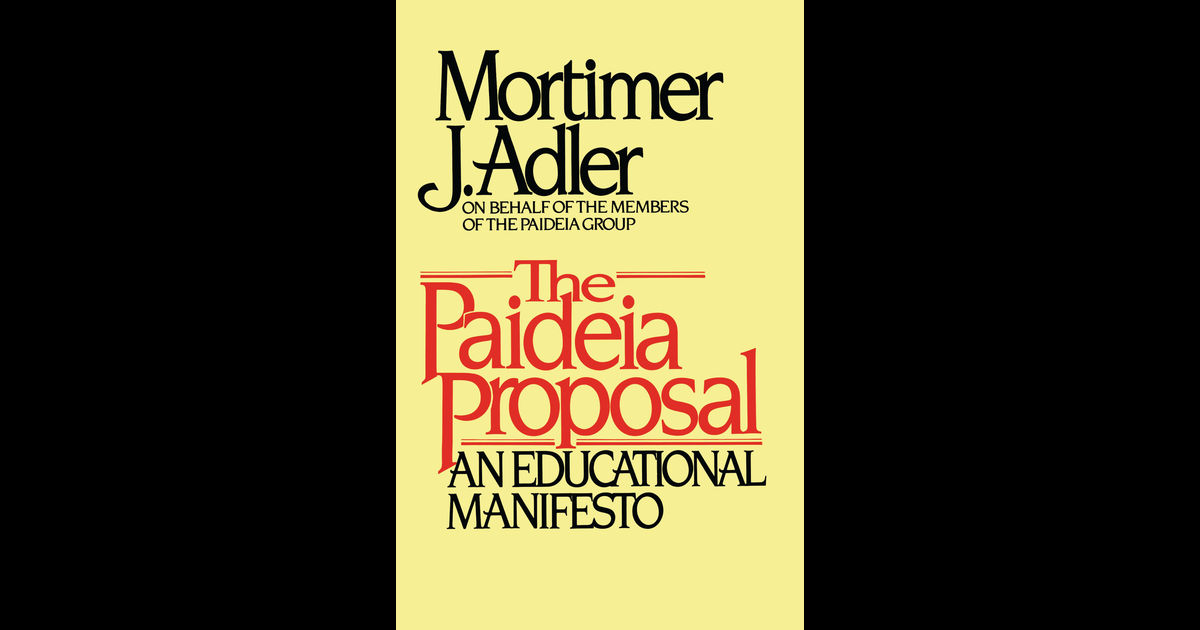The Paideia Proposal was a K-12 educational reform plan established by Mortimer Adler. The description that follows is drawn from the article Reconstituting the Schools, in the 1988 edition of his book Reforming Education, The Opening of the American Mind, originally published in 1977. The purpose of the Paideia Proposal was to offer a system of liberal education for all children in the United States, not just those expected to attend college.
This proposal was grounded on the assumptions to contradict the common mistakes made by educators. The assumptions are as follows:
1) all children can be educated;
2) education is never finished in school or higher institutions of learning, but is a lifelong process of maturity for all citizens;
3) the primary reason for learning is the activity of the child’s mind, which is not created by, but only supported by the teacher;
4) multiple kinds of learning and teaching must be used in education, not just teacher lecturing, or telling;
5) a student’s preparedness for earning a living is not the primary objective of schooling.
In addition, he believed that individual differences, especially with respect to the natural endowments and natural environments from which children come, must be compensated by remedial or supplementary instruction and preschool tutoring, as needed.
He emphasized that the proposal is much more than just a return to the basics skills of reading, writing and arithmetic. Nor is it simply a return to the classics of Greek and Roman antiquities. It is a return only to what is of enduring value, and is a Democratic proposal for the education of all students, in contrast to being what was at times characterized by opponents as an elitist program.
He proposed a curriculum structure within which separate states or school districts could pluralistically vary constituent areas of study.
Proposed Curriculum
- This has 3 groups with a fourth auxiliary manual skills category, which are necessary in acquiring mental agility in learning with one’s hands, and a fifth auxiliary category introducing students to the world of work
1) Language, Literature and the Fine Arts;
2) Mathematics and Natural Science;
3) History, Geography and Social Studies;
4) Physical Education (12 years), Manual Training including cooking, sewing, typing, machine repair (6 years);
5) general introduction to the world of work (last 2 years).
Principles of the Paideia Proposal:
- This involved 3 important types of learning and respective types of teaching
- Characterized as knowing that, knowing how and knowing why
1) Didactic instruction (traditional lecturing) was by and large the main mode of teaching being applied in the traditional system. Its purpose was for obtaining organized knowledge or facts. Adler placed the least value on this form of knowledge and argues that it is generally short-lived, tending to fade away with time. He admits that he had forgotten almost all of the information that was learned in school under this category.
2) Coaching is performed so that the student may procure skills, such as reading, writing, speaking, listening, calculating, problem-solving, estimating, measuring, and exercising critical judgment. Skills are habits, not memories, thus are much more durable than memories, especially memories not established upon understanding. Skills must also be kept to remain sharp, and are less durable than the understanding achieved through the Socratic method.
3) The Socratic method (extended discussion) is the only path to understanding basic ideas and values. This cannot be acquired through didactic teaching or coaching. The basis of discussion cannot be textbooks, but must be works of art and books that deal with ideas and values. Adler states that our teachers are totally untrained for this. The seminars would be constructed in two dimensions:
- Vertical dimension: the teacher would give and order questions aimed at the development of understanding ideas (not for covering predetermined ground).
- Horizontal dimension: discussion would be open to all potential answers from students in response to the questions.
If a seminar is too open in both dimensions or focused primarily within the horizontal dimension, it may become loose and undirected. When it is directed and controlled in both dimensions or focused primarily on the vertical dimension, it becomes didactic and dogmatic. Seminars will vary immensely depending upon subject matter and participants, but Adler feels that by following his prescription, any teacher that is a superior learner cannot fail to permit his students to also become inspired learners.
The Paideia Proposal was a response to what Adler characterized as our antidemocratic or undemocratic educational system, a holdover from the 19th century. This was related to the late arrival in the United States of a truly democratic system of universal suffrage and human rights in the twentieth century. He believed that a system oriented primarily for vocational training has as its objective training the slaves, not free men, and that the only kind of preparation essential for vocational work is to learn how to learn, since many skilled jobs would be vanishing.
